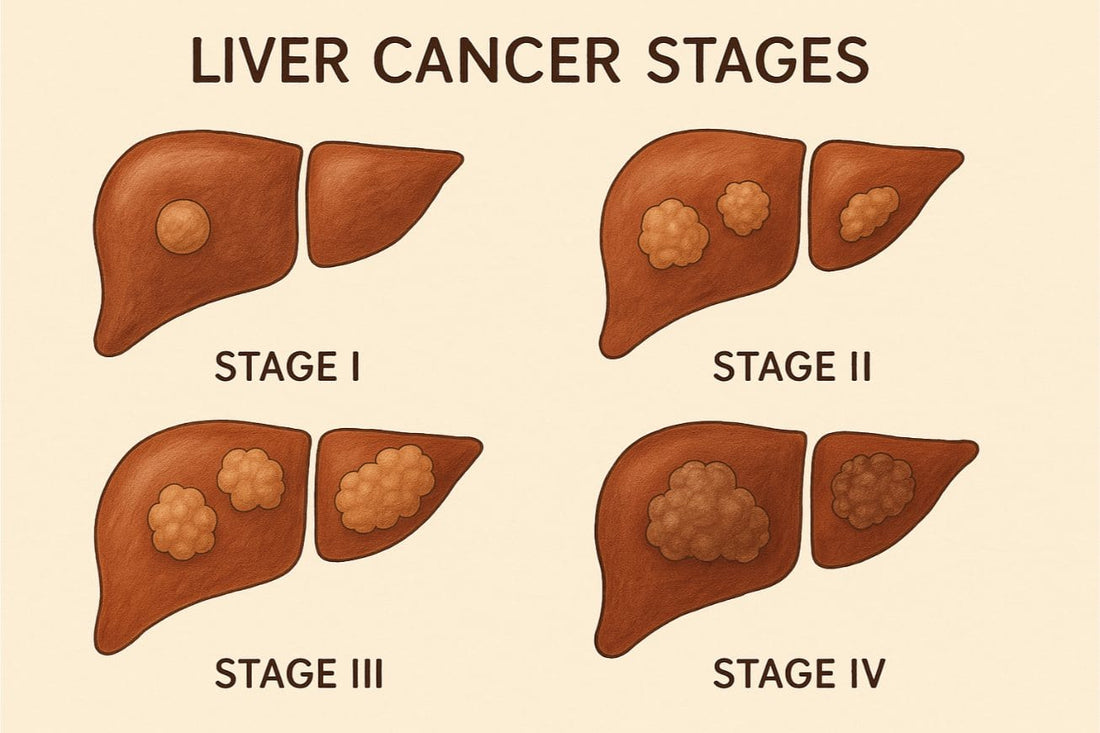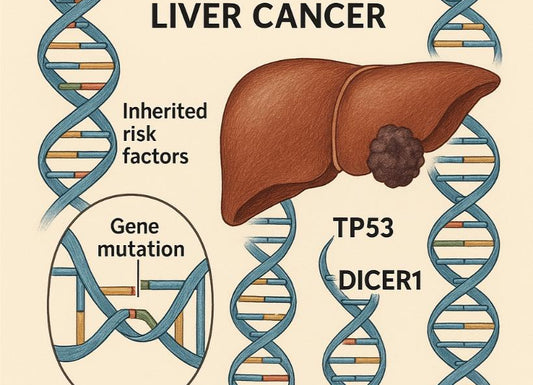Liver Cancer Stages
 Written By
Abel Tamirat, MD
Written By
Abel Tamirat, MD

Liver cancer is a serious and potentially life-threatening condition. Understanding its stages is crucial for determining the right treatment approach and predicting outcomes. The stage of liver cancer at diagnosis influences not only the therapeutic options available but also the expected prognosis and survival rates. Medical professionals use various staging systems to assess how far the cancer has progressed and to plan the most effective course of action.
What Are the Stages of Liver Cancer?
After a liver cancer diagnosis, one of the first things doctors do is determine whether the cancer has spread and if so, how far. This process is known as staging, and it's a crucial step in understanding the full picture of the disease.
Staging helps describe how much cancer is present in the body and where it’s located. It plays a key role in guiding treatment decisions and gives both doctors and patients a clearer idea of what to expect moving forward. Staging is also used when discussing survival statistics and comparing treatment outcomes.
Liver cancer is typically staged from Stage I (1) to Stage IV (4). In general, the lower the stage, the smaller and more contained the cancer is. A higher stage, such as Stage IV, means the cancer has spread more extensively, possibly to other organs.
While every individual’s journey with cancer is unique, cancers at the same stage often behave in similar ways and are treated using similar approaches. That’s why understanding the stage is so important. It helps chart the best course of action.
Understanding the Stages of Liver Cancer Progression
Liver cancer progresses from localized tumors in the early stages to more extensive involvement, including spread to lymph nodes and other organs. Early-stage liver cancer may present with minimal or no symptoms, while advanced stages often involve jaundice, weight loss, abdominal pain, and fluid accumulation. The speed of progression varies depending on tumor biology and underlying liver health. In some cases, liver cancer can progress rapidly, especially in patients with pre-existing liver disease.
Liver Cancer Staging Systems: How It Works
Three major systems are used for liver cancer staging:
-
TNM System: Focuses on tumor size, lymph node involvement, and metastasis.
-
Barcelona Clinic Liver Cancer (BCLC): Includes tumor stage, liver function (Child-Pugh), physical health, and cancer-related symptoms.
-
Child-Pugh Score: Assesses liver function based on bilirubin levels, albumin, INR, ascites, and encephalopathy.
The TNM system is the most widely used cancer staging system. Most hospitals and medical centers use the TNM system as their main method for cancer reporting. You are likely to see your cancer described by this staging system in your pathology report unless there is a different staging system for your type of cancer.
Comprehensive Liver Cancer Staging and Tumor Size Chart

A tumor size chart helps patients and caregivers understand the correlation between tumor dimensions and cancer stages. For example:
-
Tumor <2 cm: Typically Stage I
-
Tumor 2-5 cm: May be Stage II
-
Tumor >5 cm or multiple tumors: Stage III or higher
Charts like these aid in visualizing where a patient might fall within the staging spectrum and can be presented in interactive or downloadable formats for ease of access.
How Liver Cancer Tumor Size Affects Staging
Tumor size is a critical factor in staging. A 10 cm liver tumor is generally categorized in Stage III or higher, indicating more advanced disease. Larger tumors often limit surgical options and may require alternative treatments such as embolization, targeted therapy, or transplantation. The tumor's size also influences the likelihood of spread and prognosis.
Different Stages of Liver Cancer and Their Symptoms
In early stages, liver cancer may not cause noticeable symptoms. As the disease progresses, symptoms become more apparent and severe. Common symptoms by stage include:
-
Stage I: Often asymptomatic
-
Stage II: Mild discomfort, fatigue, minor liver function changes
-
Stage III: Abdominal pain, weight loss, jaundice, fluid retention
-
Stage IV: Severe pain, liver failure symptoms, metastasis-related complications
Some patients remain asymptomatic until the cancer is well advanced, underscoring the importance of regular screening for high-risk individuals.
Is There a Stage 5 Liver Cancer?
There is no Stage 5 in liver cancer. The staging ends at Stage IV, which signifies the most advanced form of the disease. End-stage liver cancer typically involves widespread metastasis and significant liver function impairment. At this point, treatment focuses more on palliative care, aiming to relieve symptoms and improve quality of life rather than cure the disease.
Key Factors Influencing Liver Cancer Staging and Treatment
Several factors contribute to the staging of liver cancer, including:
-
Tumor size and number
-
Liver function (Child-Pugh score)
-
Presence of metastasis
-
Patient's overall health and performance status
Stages can sometimes change due to treatment response or disease progression. Reassessment may lead to a revised treatment plan.
Liver Cancer Stage and Prognosis: What to Expect
Survival rates differ significantly by stage:
- Stage I: 5-year survival up to 70% with treatment
- Stage II-III: 5-year survival ranges from 30-50%
- Stage IV: 5-year survival drops to less than 10%
Early detection greatly improves the likelihood of successful treatment. While liver cancer can be fatal, it does not always lead to death, particularly if caught early and treated effectively.
How Liver Cancer Staging Affects Treatment Options

Treatment decisions are heavily based on staging. Options include:
-
Stage I: Surgery or liver transplantation
-
Stage II: Surgery, embolization, ablation
-
Stage III: Targeted therapy, chemotherapy, limited surgery
-
Stage IV: Palliative care, clinical trials
Accurate staging allows doctors to tailor treatments for the best possible outcomes.
Can Liver Cancer Be Misdiagnosed or Staged Incorrectly?
Yes, misdiagnosis or incorrect staging can occur due to limitations in imaging, biopsy sampling, or misinterpretation of symptoms. To reduce errors, doctors may use multiple diagnostic tools and seek second opinions. Advanced imaging techniques and biopsies play critical roles in staging accuracy.
Real-Life Stories: Patients' Journeys Through Liver Cancer Stages
Case studies highlight the importance of early detection and the variability of patient outcomes. Some patients diagnosed at Stage I have experienced full recovery through surgery, while others with late-stage liver cancer have achieved extended survival with targeted therapies. These real-life journeys offer hope and practical insights for newly diagnosed patients.
Prevention & Early Detection: How to Lower Your Risk

Reducing liver cancer risk involves:
-
Limiting alcohol and avoiding tobacco
-
Maintaining a healthy weight
-
Managing diabetes and fatty liver disease
-
Screening for hepatitis B and C
-
Getting vaccinated against hepatitis B
-
Using at-home liver health tests like Ribbon Checkup's at-home urine test kits for early detection
Early detection through regular screening is the most effective way to improve outcomes.
Conclusion: Why Liver Cancer Staging Matters
Understanding the stages of liver cancer is essential for effective diagnosis, treatment, and management. Staging provides a clear insight into the severity of the disease and helps chart the best course of action. By staying informed and proactive about liver health, individuals can significantly increase their chances of successful treatment and improved quality of life.
Written by Abel Tamirat, MD
Dr. Abel Tamirat is a licensed General Practitioner and ECFMG-certified international medical graduate with over three years of experience supporting U.S.-based telehealth and primary care practices. As a freelance medical writer and Virtual Clinical Support Specialist, he blends frontline clinical expertise with a passion for health technology and evidence-based content. He is also a contributor to Continuing Medical Education (CME) programs.
Related Resources
- Metastatic Liver Cancer: Symptoms, Diagnosis, Treatment, and Prognosis
- What Disqualifies You from a Liver Transplant? Eligibility, Denial, and What Comes Next
- Is Liver Cancer Hereditary? Genetic Risks and Family History
References
Anand. (2024, September 24). Hepatocellular Carcinoma Staging: Staging Systems for Hepatocellular Carcinoma. Retrieved April 3, 2025, from Medscape.com website: https://emedicine.medscape.com/article/2007061-overview
Han, K. (2015). Transarterial chemoembolization in hepatocellular carcinoma treatment: Barcelona clinic liver cancer staging system. World Journal of Gastroenterology, 21(36), 10327–10327. https://doi.org/10.3748/wjg.v21.i36.10327
Liver Cancer Stages. (2025). Retrieved April 3, 2025, from moffitt website: https://www.moffitt.org/cancers/liver-hepatocellular-cancer/diagnosis/stages/
Liver Cancer Stages | American Cancer Society. (2020). Retrieved April 3, 2025, from Cancer.org website: https://www.cancer.org/cancer/types/liver-cancer/detection-diagnosis-staging/staging.html
Udoh, U.-A., Sanabria, J. D., Rajan, P. K., Banerjee, M., Schade, M., Sanabria, J. A., … Sanabria, J. R. (2021, April 6). Table 1, [The Barcelona Clinic Liver Cancer (BCLC) Staging System ()]. Retrieved April 3, 2025, from Nih.gov website: https://www.ncbi.nlm.nih.gov/books/NBK569796/table/Ch3-t0001/
Rosen, R. D., & Sapra, A. (2023, February 13). TNM Classification. Retrieved April 3, 2025, from Nih.gov website: https://www.ncbi.nlm.nih.gov/books/NBK553187/

Dr. Abel Tamirat is a licensed General Practitioner and ECFMG-certified international medical graduate with over three years of experience supporting U.S.-based telehealth and primary care practices. As a freelance medical writer and Virtual Clinical Support Specialist, he blends frontline clinical expertise with a passion for health technology and evidence-based content. He is also a contributor to Continuing Medical Education (CME) programs.



